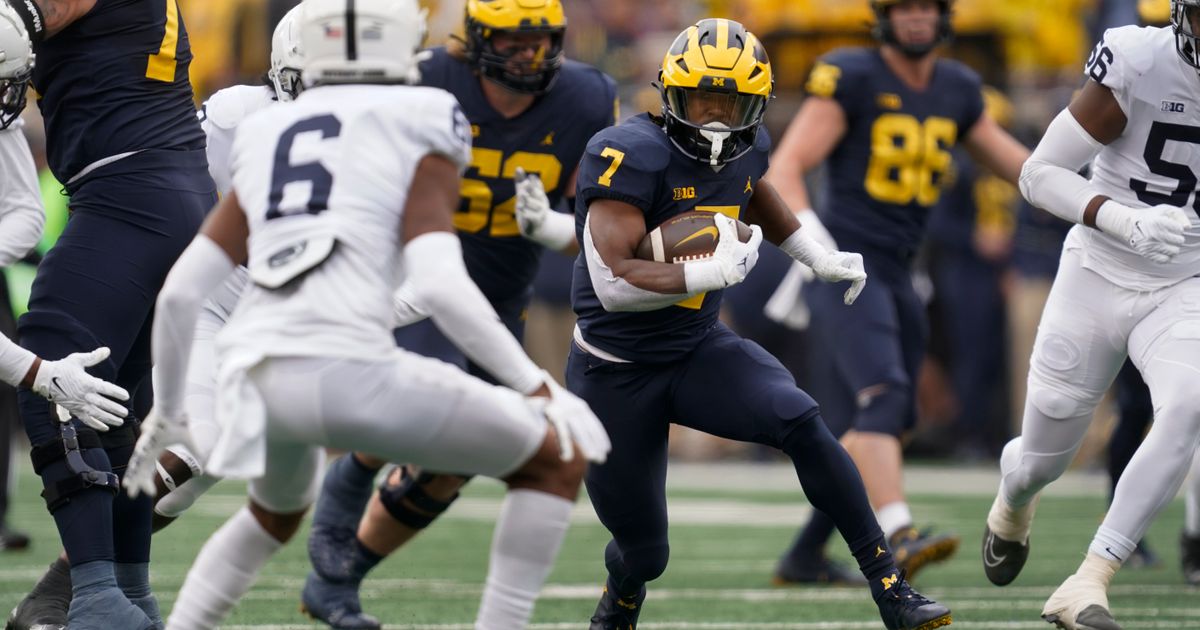
SCOTTSDALE, Ariz. (AP) — Asked to consider what previous opponents were similar to Michigan, TCU’s defensive players and coordinator mention Kansas State a lot.
A bigger Kansas State.
“We see that they have a pretty huge O-line,” Horned Frogs linebacker Dee Winters said Tuesday.
As for the Wolverines, they don’t have much experience to draw upon when it comes to facing a defense like TCU’s that uses three down linemen and three safeties.
“This is all new to us,” Michigan offensive tackle Ryan Hayes said.
No. 2 Michigan brings its smash-mouth ways into the College Football Playoff semifinal on Saturday to face No. 3 TCU. It’s tempting to boil the Fiesta Bowl matchup down to Big Ten power vs. Big 12 speed, especially when the Wolverines have the ball.
Tempting, but not entirely accurate.
“I think maybe it’s an oversimplification,” Michigan co-offensive coordinator Matt Weiss said.
For the second straight season, Michigan won the Joe Moore Award given to the best offensive line in the country.
This season’s group might be even better than last year’s, which added center Olusegun Oluwatimi to a veteran group. The Virginia transfer won the Outland Trophy (best interior lineman) and Rimington Trophy (top center) this season.
Oluwatimi, tackles Hayes and Karsen Barnhart, and guards Zak Zinter and Trevor Keegan average 308 pounds, but what makes them different from even the best Big 12 lines is they also are long and rangy.
The 6-foot-3 Oluwatimi is the only one of five starters under 6-5.
Offensive line coach Sherrone Moore is also Michigan’s co-offensive coordinator now, handling play-calling duties with Weiss. The two were promoted after Josh Gattis left for Miami following last season’s playoff appearance by the Wolverines that ended in an Orange Bowl semifinal loss to Georgia.
“I think (Moore) does a really good job of knowing what our strengths are,” Hayes said. “It’s great having him in our room. We get extra intricate detail of why are we doing this as a whole offense. He kind of lets us know what the whole offense is doing and that helps us.”
Adding to all that beef up front, Michigan loves its big personnel packages. The Wolverines will regularly use two, three, even the occasional four-tight end formation.
It is an offense Michigan coach Jim Harbaugh’s mentor, Bo Schembechler, would be proud of.
“It’s going to be quite a bit different from what we’ve gotten to see week in and week out,” TCU defensive coordinator Joe Gillespie said. “But I also feel like there’s some differences that we’ll bring to the table as well.”
The 3-3-5 defense TCU plays was born as a counter-measure to spread offenses that proliferated college football — especially the Big 12 — in the 2000s and 2010s.
Those offenses often abandon the tight end position altogether, instead going with four or five wide receivers.
Ohio State dabbles in the 3-3-5, but for the most part Michigan didn’t see much of it this season.
“So, it’s really hard to watch the tape and say, ‘OK, this will definitely work, but this won’t,’” Weiss said about game planning for TCU.
The Horned Frogs are not exactly undersized up front on defense. Nose guards Damonic Williams and Tymon Mitchell both weigh in north of 315 pounds. But usually only one of them is on the field at a time. All three of TCU’s starting linebackers are listed at 230 pounds or more.
But if TCU wants to stick with its usual five defensive backs against Michigan, those players are going to be forced to get physical in ways they typically haven’t faced this season.
Advantage, Michigan? Neither side is about to concede that.
“They look like NFL safeties and DBs,” Weiss said of the TCU secondary. “They fly up there, they tackle, they’re physical, they’re really good tacklers and they’re fast. That erases a lot of those problems.”
The Horned Frogs ranked fourth in the Big 12 — but 65th in the country — in yards per carry allowed at 4.10. By far their best defensive game came against Texas and All-American Bijan Robinson, who had 29 yards on 12 carries.
In two games against Kansas State, though, the Frogs allowed 363 yards and 4.9 yards per carry.
Meanwhile, Michigan’s offense ranked fourth in the country in yards per carry at 5.64, ninth in rushing attempts (571) and hardly dropped off when All-America running back Blake Corum went out with a knee injury in Game 11.
Donovan Edwards moved into starting role for the final two games and ran for 401 yards on 47 carries against Ohio State and Purdue.
“If they establish the run,” TCU linebacker Johnny Hodges said, “it’s going to be a long game for us.”
___
Follow Ralph D. Russo at https://twitter.com/ralphDrussoAP and listen at http://www.appodcasts.com
___
AP college football: https://apnews.com/hub/college-football and https://twitter.com/ap_top25. Sign up for the AP’s college football newsletter: https://tinyurl.com/mrxhe6f2